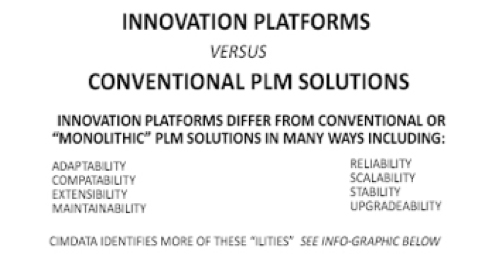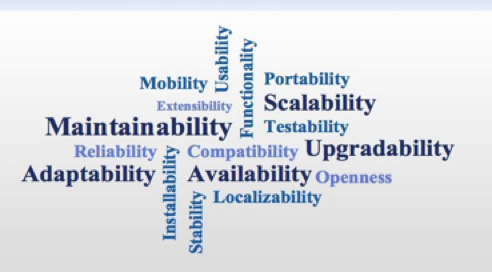Key takeaways:
- Today’s digital upheavals and disruptions threaten everything and everyone throughout the extended enterprise
- Innovation is more than ever a key to enterprise sustainability; leading enterprises are defining and enabling their PLM platform business models around that insight
- No enterprise can afford to miss the competitive advantages that come with the implementation and proper use of a product innovation platform
Lifecycle management, like every technological advancement, has a lifecycle of its own. CIMdata’s recently unveiled three position paper series on Product Lifecycle Management (PLM) platformization makes this clear. These papers covered in detail what is driving this evolution in PLM, the new forms of innovation in product development resulting from that evolution, and some very bold marketplace thrusts by the solution providers.
At the heart of the evolution of innovation, PLM solution providers are offering powerful new capabilities. These include leveraging the cloud, service oriented architectures (SOA), and other smart technologies such as enablers for the internet of things (IoT). Their strategies include a 2013-2014 surge in acquisitions of best-in-class software, on which hundreds of millions of dollars were spent, and well-thought-out new lifecycle architectures.
These acquisitions open up direct access to a myriad of applications and toolsets demanded by today’s leading innovative enterprises. More importantly, this once-in-a-generation evolution is bringing transparency to what has long been a fragmented, convoluted, opaque, and sometimes wasteful process. As was stated by Peter Bilello, CIMdata’s President, at CIMdata PLM Road Map™ this past October, “What we are doing today will not cut it tomorrow.” This applies equally to product development and to PLM implementations.
Much has been written and spoken about platformization, but viable definitions are scarce. Like PLM, innovation platforms bring together people, processes, and technologies to enable innovative new products and services, and their associated workflows and intellectual property. Compared to what can be done with innovation platforms, however, this description is “innovation-lite.”
Four Irresistible Trends
The platformization of PLM is the culmination of four irresistible trends.
First and foremost is the rapid evolution of personal productivity tools and the integration of their capabilities within an enterprise framework to support systems engineering and multi-disciplinary design creation, optimization, and validation. This includes the interoperability of digital models for simulation and analysis (or model-based engineering) irrespective of dissimilarities in toolsets. Recall how spreadsheets morphed into simulation, analysis, and all the other wonders of computer–aided engineering.
The other three:
- Migration of discrete capabilities for end-to-end lifecycle management into business units and the enterprise—onward and upward from the engineering units and their “silos of expertise.” That is where engineering document management (EDM) and product data management (PDM) originated. Lifecycle management is no longer just about better, faster, cheaper products and the ramifications are endless.
- Recognition of the ever growing and increasingly urgent need for collaboration—across engineering specialties, spanning scientific disciplines, and reaching throughout the extended enterprise. The enormous value to be extracted from intuitive collaboration and information sharing that is increasingly easy to see.
- The evolution of specific technologies such as SOAs in the cloud that enable the platformization of innovation. Fading away are closed or proprietary systems that are hosted in-house & supported by corporate information technology units.
CIMdata presents these to our lifecycle clients as the foundation upon which functional capabilities, data, and processes are enabled (i.e., put to work to innovate) and executed (i.e., sold, shipped, installed, and maintained). Lest this seem airy and insubstantial, bear in mind that innovation platforms are business strategies—as PLM has been from its beginnings. They are intended to deal with challenges at the enterprise level that cannot be resolved further down in the organization.
Solution providers have devoted hundreds of millions of R&D dollars in a quest—that is the right word—to see that users have everything they need, when they need it, all in one place. “Everything” means connecting developers to every aspect of the innovation environment. “All in one place” means the single source of truth, the Holy Grail of product knowledge. This applies to physical goods, to digital products, to systems that are a combination of these two, and to services.
The Age of Continuous Upheaval
In our age of continuous upheaval, digitization threatens to disrupt everything in an extended enterprise. Reliable and familiar technologies are sidelined. Established business processes are undermined. Workflows are turned inside out. Feedback loops multiply. Silos of expertise are rewired. Employees are jolted out of their comfort zones. Organizational charts go into the shredder.
There’s more. Gone or fading fast are long-established boundaries between enterprise disciplines such as design (e.g., mechanical, electrical/electronic, and software development), production, supply chain management, logistics, and services. The playing fields of the product lifecycle constantly tilt first in one direction and then in another. For good or ill, these changes are driving the development of innovation platforms.
Even some basic axioms of business are being questioned. One such axiom is that success is a function of being first to market. Venture capitalist Marc Andreessen tells executives in the companies he funds that the opposite is the real axiom. “The common theory is that you want to be first to market,” Andreessen was recently quoted in Inc.com. “But actually, you want to be last to market and close the door [on that industry] so no one can come after you.”
In other words, in an era of disruption, globally competitive may not be good enough. Secondly, not even bedrock concepts such as first and last are spared.
Every upheaval has its enablers. For innovation platforms, these are:
- The Internet of Things (IoT), whose sensors and connectivity reveal what happens to products, systems, and services in the field.
- The cloud and its 24/7 connectivity for just about anything imaginable.
One way to understand the importance of the IoT and the cloud is to contrast them with the advertising theme of the Las Vegas Convention Bureau: “What happens here stays here.” In innovation, notion has zero traction. It is the ultimate non-starter. Innovations and insights emerge from here, or there, or anywhere. Enterprises must not let insights disappear into silos of expertise, never to be seen again. Minimizing the difficulties with silos is why Dassault Systèmes, Aras, PTC, Autodesk, Siemens PLM Software, and others constantly work on interoperability with best-in-class solutions.
Moving Lifecycle Management from Yesterday to Tomorrow
The multi-article CIMdata story on innovation platforms is a timeline for PLM as a business strategy. These articles map lifecycle-oriented solutions to the many difficulties in product development. No need to enumerate these difficulties. Everyone has a list. The reality is that the dominant solution providers (and many smaller ones) no longer try to one-up each other. Too much is at stake for gamesmanship.
Instead, innovation platforms draw together personal productivity tools, end-to-end lifecycle management at the enterprise level, and cross-functional collaboration. End-to-end lifecycle management increasingly is about sustaining the enterprise and not just better, faster, cheaper products and services. Add to those challenges: the growing recognition of the scarcity of resources as population and incomes grow.


Many Attributes on which Innovation Platforms Outperform Conventional PLM
For all the reasons outlined above, the platformization of PLM is inevitable. No one standing in the way of these processes can achieve much in the way of success.
What this means for innovation is that the fundamental rationale of lifecycle management is evolving into something new. CIMdata defines innovation as the intellectual processes of creating new products that compete globally and sustain the enterprise through end-to-end lifecycle management. End-to-end means just that: from requirements and concepts all the way to recycling, repurposing, or remanufacturing. Product innovation, in all of its forms, is the heart of competitive, disruptive products, systems, and services.
Sustaining the Extended Enterprise
Our concluding point is about the relationships between innovation, lifecycle management, and sustaining the extended enterprise; as time passes these relationships steadily grow tighter. Recognizing these relationships is why solution providers are aggressively building end-to-end lifecycle management platforms focused on innovation. Over the long term, enterprises are sustained only by enabling innovation, fostering through-life product support, and driving organic growth (as opposed to buying up one’s competitors).
Despite their complexity, innovation platforms will ultimately make the infrastructure of product and process development completely transparent to the users. Users will be better able to work with team members no matter who they are, where they work, or their schedules. Managers will get speedier returns on investments (ROI) in lifecycle management and lower total cost of ownership (TCO). Part of both these calculations is maximizing the use of scarce resources, as in the tenets of the circular economy.
As with any technology, indirect benefits over time dwarf direct benefits. Though hard to measure, these second-order benefits are linked to how well platformization is implemented and how effectively it is used in the enterprise. Also important is how well the complete innovation cycle with its definitions, results, and intellectual property are governed with regard to the digital tsunami of big data and demands for regulatory compliance (e.g., RoHS, WEEE, REACH, ELV, and conflict minerals restrictions).
Today, PLM is gaining widespread recognition as the key to sustaining the organic growth of the entire extended enterprise. That makes innovation platforms the best strategy yet to focus the extended enterprise on developing products that, even if not disruptive, are highly innovative in themselves or take advantage of innovative processes and services.
The 21st century’s challenges to the enterprise can only be overcome with creativity, innovation, ingenuity, and resourcefulness. If innovation weakens, market shares contract and profitability slips away. The sustainability of the enterprise is placed at risk.
Fundamentally, then, platformization is a strategy for business agility, which today more than ever is not optional. No enterprise can afford to miss this opportunity.
PLM Platformization: The Essential Reading List
CIMdata, PLM Platformization Dossier. 2015. http://www.cimdata.com/en/resources/a-cimdata-dossier-plm-platformization
CIMdata. Platformization: Some Common Definitions. 2014. http://www.cimdata.com/en/platformization-some-common-definitions
CIMdata. Position Papers on PLM Platformization. http://www.cimdata.com/en/resources/complimentary-reports-research/position-papers
Bilello, Peter. How and Why PLM Is Being Transformed Into a Product-Oriented Innovation Platform (Position Paper, Part 1 of 3). Dec. 2014.
Bilello, Peter. Platformization: Dealing With a Matrix of Headaches (Position Paper, Part 2 of 3). Jan. 2015
Bilello, Peter. Linking the Physical and Virtual Worlds: PLM Platformization Sustains the ‘Organic’ Enterprise (Position Paper, Part 3 of 3). Feb. 2015.
Przybylinski, Stan. Business Strategy and Platformization. Feb. 2015.
whichPLM. PLM-as-a-Platform: A Conversation about PLM’s Evolution with Mark Burstein of NGC Software (Part One). Feb. 2015. www.whichplm.com/editors-choice/plm-as-a-platform-a-conversation-about-plms-evolution-with-mark-burstein-of-ngc-software-part-one.html
whichPLM. PLM-as-a-Platform: A Conversation about PLM’s Evolution with Mark Burstein of NGC Software (Part Two). Feb. 2015. www.whichplm.com/editors-choice/plm-as-a-platform-a-conversation-about-plms-evolution-with-mark-burstein-of-ngc-software-part-two.html
Moore, Gordon. Moore’s Law. Ca. 1970. www.mooreslaw.org
Metcalfe, Robert. Metcalfe’s Law. Ca. 1980. www.businessdictionary.com/definition/Metcalfe-s-Law.html
Estrin, Judith. Closing the Innovation Gap: Reigniting the Spark of Creativity in a Global Economy. McGraw-Hill Books. NY. 2008.
Moore, Geoffrey A. Crossing the Chasm: Marketing and Selling Disruptive Products to Mainstream Customers. HarperCollins. NY. 3rd Ed. 2014.
Moore, Geoffrey A. Inside the Tornado: Strategies for Developing, Leveraging, and Surviving Hypergrowth Markets. HarperCollins. NY. 2004.
Moore, Geoffrey A., Paul Johnson and Tom Kippola. The Gorilla Game: Picking Winners in High Technology. HarperCollins. NY. 1999.
Moore, Geoffrey A. Escape Velocity: Free Your Company's Future from the Pull of the Past. HarperCollins. NY. 2011.
Moore, Geoffrey A. Dealing with Darwin: How Great Companies Innovate at Every Phase of Their Evolution. Penguin. NY. 2008.
Ghazawneh, Ahmad. The Role of Platforms and Platform Thinking in Open Innovation Networks. Proceedings of the 43rd Hawaii International Conference on System Sciences – 2010. IEEE Computer Society. Washington. 2010.
P&G. Open Innovation Stories. P&G. www.pgconnectdevelop.com/home/stories.html
Shilovitsky, Oleg. Can BOX Become a Platform for PLM. BeyondPLM Blog. 2015. beyondplm.com/2015/01/19/can-box-become-a-platform-for-plm



